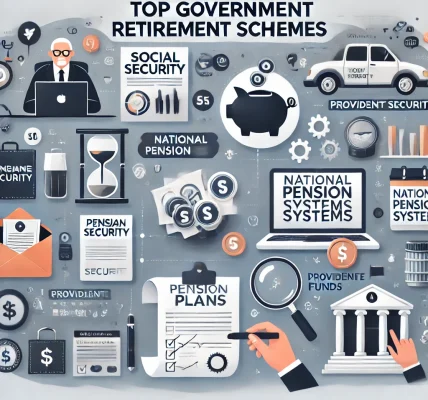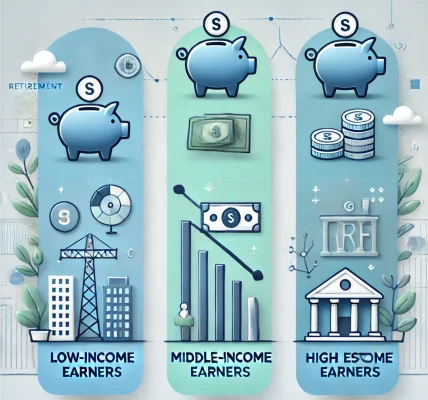Introduction
Retirement planning is crucial for ensuring financial stability in your later years. However, choosing the right retirement plan depends significantly on your income level. Whether you earn a modest salary or have a high income, selecting a plan tailored to your financial situation can help maximize your savings and provide a comfortable post-retirement life. This guide will walk you through various retirement plan options and how to choose the right one based on your income bracket.
Understanding the Importance of Income-Based Retirement Planning
Your income determines how much you can contribute, the tax benefits you can leverage, and the investment options available to you. Key factors influenced by income include:
- Contribution Limits: Higher-income individuals may have higher contribution capabilities.
- Tax Benefits: Some plans offer tax deductions, while others provide tax-free withdrawals.
- Risk Tolerance: Higher incomes allow more flexibility to invest in higher-risk assets.
- Retirement Goals: Your desired post-retirement lifestyle impacts the amount you need to save.
Retirement Plan Options Based on Income Levels
Low-Income Earners (Annual Income Below $50,000)
For individuals with lower earnings, the goal is to maximize savings while taking advantage of tax breaks and employer contributions.
1. Employer-Sponsored 401(k) or 403(b) Plans
- Many employers offer 401(k) plans (for private sector employees) or 403(b) plans (for public sector employees and non-profits).
- Employers often match contributions, providing free money for retirement.
- Contributions are pre-tax, reducing taxable income.
- Recommended action: Contribute at least enough to get the full employer match.
2. Roth IRA
- Best for individuals in a lower tax bracket who anticipate being in a higher bracket in the future.
- Contributions are made with after-tax income, and withdrawals in retirement are tax-free.
- Contribution limit (as of 2024): $7,000 per year ($8,000 if age 50 or older).
- Recommended action: Contribute as much as possible, as tax-free withdrawals provide significant long-term benefits.
3. Saver’s Credit
- A tax credit for low-income earners contributing to retirement accounts.
- Provides up to 50% of contributions back as a tax credit.
- Recommended action: Maximize contributions to qualify for this benefit.
Middle-Income Earners (Annual Income Between $50,000 – $150,000)
This group has more flexibility and can leverage both pre-tax and post-tax retirement savings options.
1. Traditional 401(k) or 403(b)
- Contributions reduce taxable income, providing immediate tax benefits.
- Employers may offer matching contributions, boosting savings.
- Investment options include stocks, bonds, and mutual funds.
- Recommended action: Contribute at least 10-15% of income to secure long-term growth.
2. Traditional IRA
- Offers tax-deductible contributions (income limits apply).
- Tax-deferred growth means you don’t pay taxes until withdrawals begin.
- Recommended action: If you don’t have an employer-sponsored plan or qualify for deductions, consider maxing out contributions.
3. Health Savings Account (HSA) (If Eligible)
- If you have a high-deductible health plan, an HSA allows tax-free savings for medical expenses.
- Funds can be used tax-free in retirement for medical costs.
- Recommended action: Use this as a supplemental retirement savings vehicle.
High-Income Earners (Annual Income Above $150,000)
Higher earners must focus on tax efficiency and diversifying investments to ensure optimal growth and withdrawal strategies.
1. Maxing Out 401(k) Contributions
- In 2024, the maximum 401(k) contribution is $23,000 ($30,500 if age 50 or older).
- Contributions reduce taxable income significantly.
- Recommended action: Max out contributions and take full advantage of employer matching.
2. Backdoor Roth IRA
- High earners are typically ineligible for direct Roth IRA contributions due to income limits.
- The Backdoor Roth IRA strategy allows converting a Traditional IRA into a Roth IRA.
- Recommended action: Work with a tax professional to ensure compliance and maximize benefits.
3. Taxable Brokerage Accounts
- Unlike retirement accounts, these have no contribution limits or withdrawal restrictions.
- Capital gains are taxed at lower rates compared to regular income tax.
- Recommended action: Invest in diversified assets for long-term growth.
4. Defined Benefit Plans (For Business Owners and Self-Employed Individuals)
- These pension-like plans allow high annual contributions.
- Tax advantages and guaranteed income in retirement.
- Recommended action: If self-employed, consult with a financial advisor to set up the best option.
How to Choose the Right Plan Based on Your Income
1. Assess Your Tax Situation
- If you want immediate tax relief, a Traditional 401(k) or IRA is better.
- If you prefer tax-free withdrawals later, go for a Roth IRA or Roth 401(k).
2. Consider Employer Contributions
- If your employer offers a 401(k) match, prioritize contributions to get the full match—it’s essentially free money.
3. Diversify Your Retirement Accounts
- Use a combination of Traditional and Roth accounts to balance tax benefits.
- High-income earners should also consider taxable investment accounts.
4. Factor in Your Retirement Goals
- Estimate your retirement expenses and income needs.
- Use online calculators or consult a financial planner to determine savings targets.
5. Adjust Contributions as Income Grows
- Increase your contributions whenever you receive a raise or bonus.
- Aim to save at least 15-20% of your income for retirement.
Common Mistakes to Avoid
- Not Starting Early: The sooner you start, the more compound interest works in your favor.
- Ignoring Employer Contributions: Failing to contribute enough to get the full match is leaving money on the table.
- Not Reviewing Plans Regularly: Income changes should prompt a review of your retirement strategy.
- Focusing Only on One Type of Plan: Diversification across tax-advantaged and taxable accounts is key.
- Withdrawing Funds Early: Early withdrawals can result in penalties and lost growth potential.
Conclusion
Choosing the right retirement plan based on your income requires careful consideration of tax implications, investment options, and long-term financial goals. Low-income earners should focus on maximizing employer contributions and tax credits, middle-income earners should take advantage of both pre-tax and post-tax options, while high-income earners should prioritize tax-efficient strategies and diversified investments. By making informed choices today, you can secure a financially stable and comfortable retirement future.




